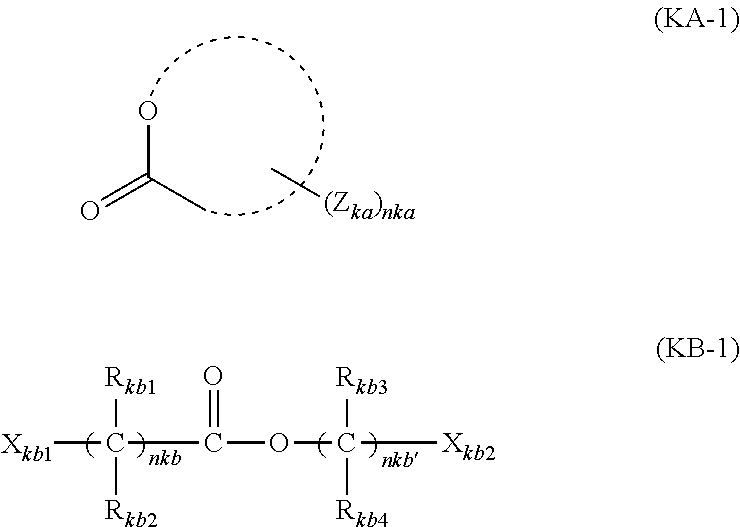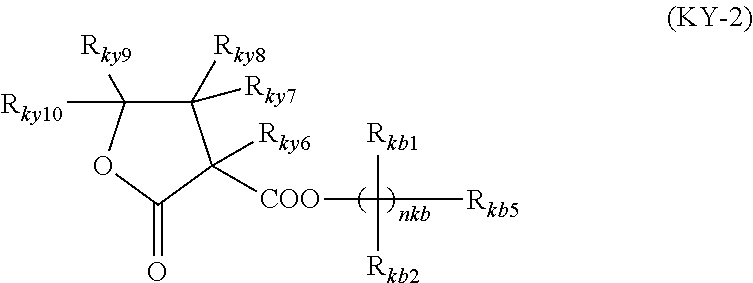Actinic ray-sensitive or radiation-sensitive resin composition and pattern forming method using the same
a technology of radiation-sensitive resin and resin composition, which is applied in the direction of photosensitive materials, instruments, photomechanical equipment, etc., can solve the problems of reducing the performance of the resist layer, deteriorating the resist layer, and bleeding out of the resist layer of the component adversely affecting the immersion liquid, so as to improve the roughness and scum generation of the pattern side wall, the effect of reducing the elution of an acid and reducing the elution ra
- Summary
- Abstract
- Description
- Claims
- Application Information
AI Technical Summary
Benefits of technology
Problems solved by technology
Method used
Image
Examples
synthesis example 1 (
Synthesis of Resin (C-8))
[0849]In a nitrogen atmosphere, 6.4 g of propylene glycol monomethyl ether acetate (PGMEA) was charged into a three-neck flask and heated to 80° C. Thereto, a solution prepared by dissolving 17.5 g of Compound (1), 4.0 g of Compound (2) and polymerization initiator V-601 (produced by Wako Pure Chemical Industries, Ltd.) in a ratio of 5.0 mol % based on the monomers, in 58.0 g of PGMEA was added dropwise over 4 hours. After the completion of dropwise addition, the reaction was further allowed to proceed at 80° C. for 4 hours. The resulting reaction solution was left standing to cool and then added dropwise to a mixed solution of 1,300 g of methanol / 150 g of distilled water over 20 minutes, and the powder precipitated was collected by filtration and dried, as a result, 15.2 g of Polymer (C-8) was obtained.
[0850]The weight average molecular weight of Polymer (C-8) obtained was 8,000 in terms of standard polystyrene and the polydispersity (Mw / Mn) was 1.3.
[0851]
[...
synthesis example 2 (
Synthesis of Resin (1))
[0853]In a nitrogen atmosphere, 8.6 g of cyclohexanone was charged into a three-neck flask and heated to 80° C. Thereto, a solution prepared by dissolving 9.8 g of 2-adamantyl-isopropyl methacrylate, 4.4 g of dihydroxyadamantyl methacrylate, 8.9 g of norbornane lactone methacrylate and polymerization initiator V-601 (produced by Wako Pure Chemical Industries, Ltd.) in a ratio of 8 mol % based on the monomers, in 79 g of cyclohexanone was added dropwise over 6 hours. After the completion of dropwise addition, the reaction was further allowed to proceed at 80° C. for 2 hours. The resulting reaction solution was left standing to cool and then added dropwise to a mixed solution of 800 ml of hexane / 200 ml of ethyl acetate over 20 minutes, and the powder precipitated was collected by filtration and dried, as a result, 19 g of Resin (1) was obtained. The weight average molecular weight of the obtained resin was 8,800 in terms of standard polystyrene and the polydispe...
PUM
| Property | Measurement | Unit |
|---|---|---|
| wavelength | aaaaa | aaaaa |
| optical purity | aaaaa | aaaaa |
| optical purity | aaaaa | aaaaa |
Abstract
Description
Claims
Application Information
 Login to View More
Login to View More - R&D
- Intellectual Property
- Life Sciences
- Materials
- Tech Scout
- Unparalleled Data Quality
- Higher Quality Content
- 60% Fewer Hallucinations
Browse by: Latest US Patents, China's latest patents, Technical Efficacy Thesaurus, Application Domain, Technology Topic, Popular Technical Reports.
© 2025 PatSnap. All rights reserved.Legal|Privacy policy|Modern Slavery Act Transparency Statement|Sitemap|About US| Contact US: help@patsnap.com



